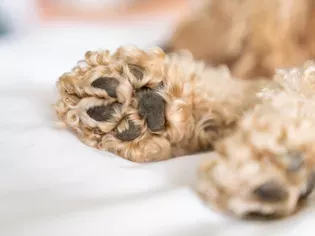8 Common Dog Paw Problems
Updated on 05/27/24

8 Common Dog Paw Problems: Detection, Treatment, and Prevention
Your dog's paws are essential for their mobility, comfort, and overall well-being. However, these hardworking appendages can be prone to various health issues that can cause discomfort, pain, and even lameness. Understanding the most common dog paw problems is crucial for responsible pet owners to ensure timely detection, appropriate treatment, and effective prevention.
1. Interdigital Cysts
These are fluid-filled sacs that develop between the toes. They are common in breeds with webbed feet or excessive hair growth between the toes, such as Poodles and Cocker Spaniels. Symptoms include swelling, redness, and discomfort. Treatment typically involves antibiotics and topical anti-inflammatories.
Example: Bella, a 5-year-old Poodle, developed an interdigital cyst between her front toes. The cyst caused her to limp and lick her paw excessively. She was prescribed antibiotics and topical ointment, which resolved the cyst within a few weeks.
2. Paw Abscesses
Abscesses are pus-filled pockets that occur beneath the skin. They are usually caused by cuts or punctures from sharp objects, such as thorns or glass. Symptoms include swelling, redness, heat, and pain. Abscesses require surgical drainage and antibiotics.
Example: Max, a 2-year-old Golden Retriever, stepped on a thorn while chasing a squirrel. The thorn caused a small cut on his paw, which later developed into an abscess. Surgical drainage and antibiotics were performed to treat the infection.
3. Nail Problems
Dogs' nails can become overgrown, cracked, or infected. Overgrown nails can cause discomfort, lameness, and even develop into infections. Symptoms include excessive clicking or tapping sounds when walking, difficulty walking, and redness or swelling around the nail bed. Treatment depends on the severity of the problem and may include nail trimming, antibiotics, or surgery.
Example: Buddy, a 10-year-old German Shepherd, had overgrown nails that were causing him discomfort. His owner trimmed his nails regularly, which prevented further problems and kept him comfortable.
4. Allergies
Dogs can develop allergies to various substances, including grass, pollen, and certain foods. Allergies can cause paw itching, redness, and swelling. Treatment involves identifying and avoiding the allergens, as well as using antihistamines or corticosteroids.
Example: Lucy, a 3-year-old Beagle, developed allergies to grass and pollen. Her paws were itchy and red, and she often licked them excessively. Antihistamines were prescribed to control the allergic reactions and provide relief.
5. Lick Granulomas
These are round, raised lesions that develop due to excessive licking. They are often caused by allergies, anxiety, or other underlying medical conditions. Symptoms include a raised, crusty lesion, and persistent licking. Treatment involves addressing the underlying cause and using topical medications or surgical removal of the granuloma.
Example: Riley, a 5-year-old Bulldog, developed a lick granuloma on his front paw. The granuloma was caused by allergies, and after identifying and avoiding the allergens, the granuloma gradually resolved with topical ointment.
6. Foreign Bodies
Dogs can step on or get foreign bodies stuck between their toes, such as thorns, splinters, or small stones. Foreign bodies can cause pain, inflammation, and infection. Symptoms include lameness, licking, and swelling. Treatment involves removing the foreign body and providing appropriate medications.
Example: Oliver, a 1-year-old Labrador Retriever, stepped on a thorn while playing in the park. The thorn got stuck between his toes, causing him to limp and lick his paw. The foreign body was removed by a veterinarian, and Oliver made a full recovery.
7. Pad Burns
Paw pads can become burned from hot pavement, chemicals, or extreme temperatures. Symptoms include redness, blistering, and pain. Treatment involves cooling the burned area, applying topical ointments, and avoiding exposure to the burn source.
Example: Molly, a 2-year-old Husky, suffered from pad burns after walking on hot pavement during a summer heatwave. The pads were red and blistered, and she had difficulty walking. Cold compresses and topical ointment were applied to soothe and heal the burns.
8. Skin Infections
Various fungal, bacterial, and yeast infections can affect the skin of the paws. Symptoms include itching, redness, swelling, and discharge. Treatment involves identifying the causative organism and using appropriate topical or oral medications.
Example: Daisy, a 4-year-old Border Collie, developed a fungal infection on her paws. The infection caused her paws to be red, itchy, and flaky. Antifungal medication was prescribed to treat the infection and restore the health of her paws.
Prevention Tips
Preventing dog paw problems is crucial for maintaining the comfort and well-being of your canine companion. Here are a few tips to keep their paws healthy:
* Regularly check your dog's paws for any cuts, swelling, or other abnormalities.
* Trim your dog's nails regularly to prevent overgrowth and potential problems.
* Wipe your dog's paws with a damp cloth after walks to remove dirt and debris.
* Keep your dog's bedding and living areas clean to reduce the risk of infections.
* Use pet-friendly sunscreen to protect your dog's paws from sunburns during outdoor activities.
* Consult with your veterinarian if you notice any changes in your dog's paws or if they are licking or chewing at them excessively.
By understanding the common paw problems that can affect dogs, you can be proactive in detecting them early, providing appropriate treatment, and implementing effective prevention measures. Remember that your dog's paws are essential for their quality of life, and by caring for them, you are ensuring their continued comfort and mobility.
Explore More Pets

Basic Training
Puppy and Baby Introductions

Working Dog Breeds
All About Search and Rescue Dogs

Dog Treatments
Puppy Vaginitis: Signs, Causes and Treatment

Dog Adoption
After More Than 1,200 Days in the Shelter, Coco Goes Home

Basic Training
How to Train Your Puppy to Go on Potty Pads

Hybrid Dog Breeds
The Difference Between a Mutt, Mixed Breed, or Designer Dog?

Dog Treatments
Nail Problems in Dogs

Puppies
7 Reasons Why Two Dogs Are Better Than One
